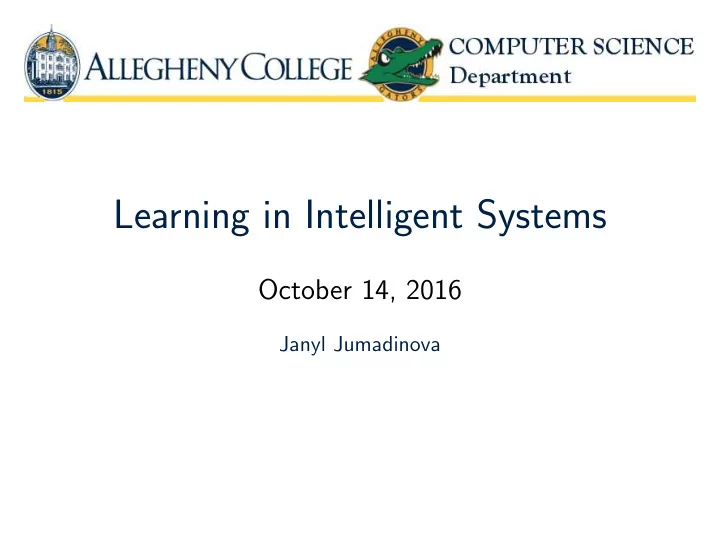

Learning in Intelligent Systems October 14, 2016 Janyl Jumadinova
Overview of Learning 2/19
Learning in Humans ◮ The act / process of acquiring, modify or reinforcing knowledge or skills through synthesizing different types of new or existed information. 3/19
Learning in Humans ◮ The act / process of acquiring, modify or reinforcing knowledge or skills through synthesizing different types of new or existed information. ◮ Key to human survival. 3/19
Learning in Humans ◮ The act / process of acquiring, modify or reinforcing knowledge or skills through synthesizing different types of new or existed information. ◮ Key to human survival. ◮ Progress over time tends to follow learning curves (relatively permanent). 3/19
Learning in Computing Systems ◮ Computational methods using “experience” to improve performance. 4/19
Learning in Computing Systems ◮ Computational methods using “experience” to improve performance. ◮ Experience − data driven task 4/19
Learning in Computing Systems ◮ Computational methods using “experience” to improve performance. ◮ Experience − data driven task ◮ Computer science – involves learning algorithms, analysis of complexity, and theoretical guarantees. 4/19
Learning in Computing Systems Artificial intelligence | Machine learning 5/19
Learning in Computing Systems Artificial intelligence | Machine learning ◮ Computer program(s) with adaptive mechanisms that enable computer / machine to learn from experience /example / analogy / rewards. 5/19
Learning in Computing Systems Artificial intelligence | Machine learning ◮ Computer program(s) with adaptive mechanisms that enable computer / machine to learn from experience /example / analogy / rewards. ◮ It improves the performance of an intelligent system over time (e.g, reducing error rate, improving rewards). 5/19
Why Learning in Computing Systems? ◮ Understand and improve efficiency of human learning / understanding. 6/19
Why Learning in Computing Systems? ◮ Understand and improve efficiency of human learning / understanding. ◮ Discover new things or structure that is unknown to humans. 6/19
Why Learning in Computing Systems? ◮ Understand and improve efficiency of human learning / understanding. ◮ Discover new things or structure that is unknown to humans. ◮ Fill in skeletal or incomplete knowledge / expert specifications about a domain. 6/19
Applications of Learning Mainly in decision making / pattern recognition / intelligent systems. 7/19
Applications of Learning Mainly in decision making / pattern recognition / intelligent systems. ◮ Robot navigation. ◮ Automatic speech recognition (Siri in iPhone, Google speech-to-text search). ◮ Search and recommendation (Google, Amazon, eBay). ◮ Financial prediction, fraud detection, medical diagnosis. ◮ Video games, data visualization. 7/19
Black-box Learning 8/19
Learning Architecture 9/19
Learning Paradigms ◮ Supervised learning - input-output relationships 10/19
Learning Paradigms ◮ Supervised learning - input-output relationships ◮ Unsupervised learning - relationship among inputs 10/19
Learning Paradigms ◮ Supervised learning - input-output relationships ◮ Unsupervised learning - relationship among inputs ◮ Reinforcement learning - input-action relates to rewards / punishment 10/19
Learning Paradigms ◮ Supervised learning - input-output relationships ◮ Unsupervised learning - relationship among inputs ◮ Reinforcement learning - input-action relates to rewards / punishment ◮ Rule learning - discovering common relationship to develop rules 10/19
Supervised Learning Given examples of inputs and corresponding desired outputs. 11/19
Supervised Learning Given examples of inputs and corresponding desired outputs. Tasks : ◮ Classification (categorizing output: correct class) ◮ Regression (continuous output to predict output based for new inputs) ◮ Prediction (classify / regression on new input sequences) 11/19
Supervised Learning 12/19
Unsupervised Learning Given only inputs and automatically discover representations, features, structure etc. 13/19
Unsupervised Learning Given only inputs and automatically discover representations, features, structure etc. Tasks : ◮ Clustering (to group similar data into a finite number of clusters / groups) ◮ Vector Quantization (compress / decode dataset into a new representation but maintaining internal information) ◮ Outlier Detection (select highly unusual cases) sequences) 13/19
Unsupervised Learning 14/19
Reinforcement Learning ◮ Learning approach of getting a computer system to act in the world so as to maximize its rewards. 15/19
Reinforcement Learning ◮ Learning approach of getting a computer system to act in the world so as to maximize its rewards. ◮ Consider teaching a domestic animal. We cannot tell it what to do, but we can reward / punish if it does the right/ wrong thing. 15/19
Reinforcement Learning ◮ Learning approach of getting a computer system to act in the world so as to maximize its rewards. ◮ Consider teaching a domestic animal. We cannot tell it what to do, but we can reward / punish if it does the right/ wrong thing. ◮ Process to determine what it did that made it get the reward / punishment – “credit assignment problem.” 15/19
Reinforcement Learning 16/19
Rule Learning Given multiple measurements to discover very common settings in term of causal-effect. 17/19
Rule Learning Given multiple measurements to discover very common settings in term of causal-effect. Tasks : ◮ Association rules (to group similar data into a finite number of clusters / groups) 17/19
Rule Learning Given multiple measurements to discover very common settings in term of causal-effect. Tasks : ◮ Association rules (to group similar data into a finite number of clusters / groups) ◮ Classification rules (compress / decode dataset into a new representation but maintaining internal information) 17/19
Rule Learning 18/19
Learning Paradigms and Some Techniques 19/19
Recommend
More recommend